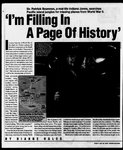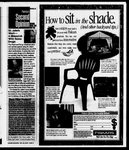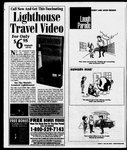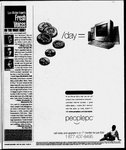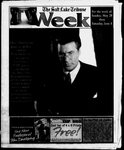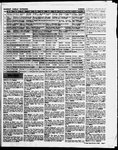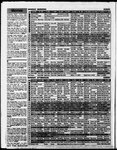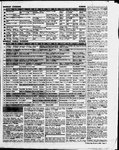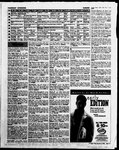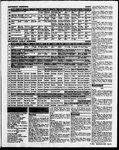| OCR Text |
Show The Salt Lake Tribune OPINION AAS Sunday, May28, 2000 National Forest Roadless Conservation Proposal Needs Public Involvement BY JACK BLACKWELL On May9, the Forest Service unveiled a proposal to end road construction in nearly one-quarter of the 192 million-acre National Forest System. More than 25 years of local planning, lawsuits and controversy havefailed to resolve the roadless area issue. Our proposal would ensure that the great- est threatto the values of roadless lands is removed and that their important characteristics are evaluated and protected as appropriate through forest planning at thelocal levelin the future. This proposal is especially important in the West. In the 32 million-acre Intermountain Region, which includes Nevada, Utah, northeastern Wyoming and southern Idaho, this proposal would apply to about 16 million acres of Inventoried roadless areas.In Utah, with 8 million acres of national forest land, the inventoried roadless acres by for- est are: 796,000 acres on the Ashley National Forest; 776,000 on the Dixie National Forest; 717,000 on the Fishlake National Forest; 600,000 acres on the Manti-La Sal National Forest; 528,000 on the Unita National Forest and 599,000 acres on the Wasatch-Cach National Forest for a total of slightly more than 4 million acres. In addition to the inventoried roadless areas, this proposal also provides procedures to analyze otherportionsof the NationalForest System with roadless charac- teristics for further protection through Forest Planning processes in the future. The proposal does not create additional wilderness areas as somehavecharacterized it. There are currently 773,000 acres of designated wilderness in the national forests of Utah, and this would not be changed by this proposal. As more and more ofprivate lands, forests, open space, wetlands andfarm landare developed, the social andecological val- Roosevelt's definition than the issue of road construction in roadless areas. ues of the National Forest Sys- tem’s roadless areas become increasingly important. We especially see development occurring along the Wasatch Front in Utah, around the growing Boise posal since it was announced in October 1999. Somewill argue that served. By halting the construction of new roadsinto roadless ar- value“them as refuges for rare plant, wildlife and fish species, settings for quality recreation and eas, we are shifting our resources into maintaining and reconstruct- spiritual renewalfor local, national, and international visitors, and reference areas for research and est travel plans that people use ing theexisting roadsin local Formostoften. The Forest Service has a huge $8 billion backlog of road scientific study. On a more basic level, many of these watersheds provide clean, pure drinking water for thousands of communities. Theodore Roosevelt once described conservationas “applying this proposal does not go far enough; that we should ban all managementactivates in roadless areas. Others will say it goes too far; that it will eliminate multiple usesin these lands. NowtheDraft Environmental Impact Statement is available, andit is the time for youto voice your informed preferencesaboutthis proposal. Take the maintenance and reconstruction timeto find out whatit is the For- for its existing road system. The backlog in the Intermountain Re- est Service is andis not proposing. gion is approximately $1.8 billion, and this at a time whenthe Forest public meetings Get involved andlet us hear from you. The commentperiod is open until July 17. More than 300 public meetings are scheduled nation- tion that will help youin formulating your comments. Thesecondset of meetings in June will provide you an opportunityfor verbal and written comment. Weare also using the Internet to bring the infor- mation and comment process to you: all the documents related to the proposal are available at www.roadless.fs.fed.us. You can find the Roadless Conservation Project meeting nearest you at this same address, or proposal will continue to improve based on public involvement and review. Let us hear from you! common sense to common problems for the common good.” Few Service receives about 20 percent of the funding needed to take care of our existing road system. It wide to share information and collect the thoughts and ideas of peo- issues makeslittle sense to build new Forester for the Intermountain Re- ple gion of USDA Forest Service. are more relevant to in communities large and Jack Blackwellis the Regional BY DAVID RIGGSand DANIEL SIMMONS FOR THE BRIDGE NEWS The Los Alamosfire started as a small, prescribed burn that quickly wentoutofcontrol, leaving a trail ofdevastation. Thefire has sofarforced 20,000 people to evacuate, burned 220 homes,left 400 families homeless and caused an estimated $1 billion in damage. It’s also damaged the environment, charring over 44,000 acres, destroying animal and plant habitats and releasing tons of pollutants into the air, ncluding toxic chemicals. INDUSTRIAL SUPPLY US Small Business Administration Subcontractorof the year 2000 government. Although manyof us have fond memories of the fire-conscious bear, the system of fire suppression — putting outfires as soon as they are discovered — has resulted in an unnaturally large buildup of dry, highly flammable wood in the nation’sforests. This leaves more wood in the forest to burn tomorrow,and the fire hazard continues to grow. Excess timber can be burned up in small, prescribed fires or it can be removed by mechanical means. Federal forest management has placed a priority on prescribed burns, which should only occur when weather and moisture conditions are just right. But pastfire suppression efforts have created conditions that make prescribed burns difficultto control, The Los Alamos fire started asa small, prescribed burn that quickly wentout of control, leaving trail of devastation. The fire , has 30 far forced 20,000 people to evacuate, burned 220 homes,left 400 families homeless and caused an estimated $1 billion in damage. It also has damaged the environment, charring over 44,00 acres, destroying animal and plant habitats and releasing tons of pollutants into the air, including toxic chemicals. Other prescribed burns have had similar outcomes, such as the fire in northern California last year that burned 23 homes. Unless it is removed mechanically, most of the surplus wood has to burn eventually. Mechanical harvesting allows forest managers to remove dead, diseased timber and underbrush, without the risk of catastrophic forest fires, Catastrophic forest fires burn very intensely and the option of mechanical removal appears increasingly at odds with the federal government’s policies. In the same week, the Forest Service announced a new moratorium on road building on 43 million acres of national forest land. This moratorium limits forest management by making timber harvesting all but impossible (imagine trying to remove excess timber withoutroads). Since 1989, harvest levels in forests havefallen from 12 million board-feet a year to less than 4 million today. If mechanical removal is forbidden andprescribed burns fail to dothe job, then the de facto policy amounts to waiting for large, unplanned forestfires. The forest superintendent near Los Alamos who ordered the prescribed burn in unfavorable weather conditions has been put on administrative leave. Butit was federal policy that set the stage for the Los Alamos fire, and similar conditions exist today on about 40 million acres of the national forest system. With the federal government owning nearly one-third ofthe U.S. landmass, bureaucratic management decisions like “suppress and prescribe”are taking their toll. It’s time to hold the federal governmentresponsible for its disastrous outcomes andcall for cutting excess timber andcarrying it out of the forest. ‘Thefederal government's policy has created massive fire hazards and rieedlessly puts lives, property watersheds, fisheries and other and the environmentat risk. If we continue to put dangerous andineffective policy above common sense, we will see more fire disasters like Los Alamos. Plus, as the Los Alamos fire amply demonstrates, people and their property are at tremendous risk when they are adjacent to these national tinderboxes, But and Daniel R. Simmons is environmental policy analyst at the Competitive Enterprise Institute. cause enormous to soils, Marilyn O. Thornton Ruth O. Thompson David W. Riggs is director of Joyce O. Evans Wesalute Industrial Supply by providing our support LOCTITE. ecosystem components. land and natural resource policy Sara: STANLEY-PROTO INOUSTRIAL TOOLS 3 Bau Master Lock. Kennedy SLE uvex 4 JOBSITE STORAGE EQUIPMENT " CooperTools Bled corronation Submit Opinion Pieces 3 Ways Opinionpieces for the Sunday op-ed pages may be submitted in one of three ways: E-mail the submission to Randy Frisch, editor of the editorial page, at Rfrisch@sltrib.com Frisch, The Salt Lake Tribune, 143 S. Main, Fourth Floor, Salt Lake City, UT 84107 Send the submission by fax machine to 901-257-8515 Al] submission should in. clude name, address, telephone number and some in formation on the author so that it can be included on the end of the piece. at www.fs.fed.us/r4 under “Special Projects.” With your input, our USS.Forest Policy of Cutting Led to Los Alamos Inferno WASHINGTON — Do youlike to play with matches? Does fire fascinate you? If so, maybe you ought to apply for a job with the Park Service or the ForestService. You maynotbe aware that the massive wildfire in Los Alamos, N.M.,is a predictable resultof federal forest management and a harbingerofthings to come. Federal forest managementhas allowed dead and dying amounts ‘of wood to accumulatein forests, increasing thelikelihood ofsevere fires. It threatens the lives and property of people that live near the forest and damagesthe ecological health offorests. While forests require more intensive management, federal land management agencies have mismanaged lands in the past by suppressing all fires and now limit Management options to prescribed burns. Smokey Bear’s caution, “only you can prevent forest fires,” symbolizes decades offire suppression by the federal are The first set of meetings will share the elements of the proposal and offer you sources of informa- There has been much dialogue and speculation about this pro- in the expanding urban popula- 16 scheduled for Utah. maintain so much ofthe existing system. protecting roadless areas will tions in Nevada. Wewantroadless areas for future generations and small; when wecannotafford to properly Access is a key to providing use and enjoyment of these roadless areas. Some have charged that block public access to their public lands. This is not true. All existing and legal access would be pre- and IdahoFalls areasin Idaho, and roads into valuable roadless areas High Pertormance Industrial Toots INDUSTRIAL SUPPLY 1635 S 300 W Salt Lake City, Utah ph (801) 484-86 Fax (801) 487-0469 pply.co |













































































































































































